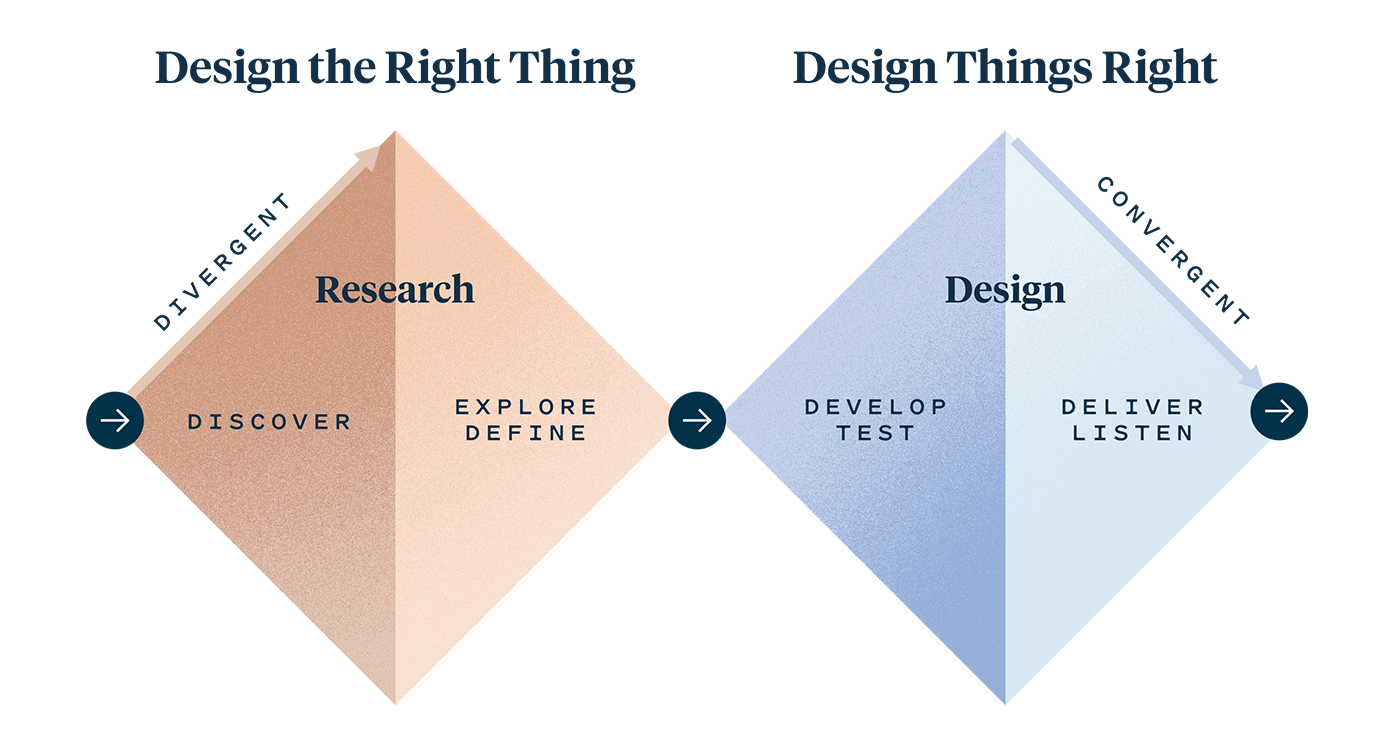When it comes to convergent vs divergent thinking, some of us favor one style of thinking over the other. You see it most clearly in the problem-solving process. When you’re solving a problem, do you tend to use logical reasoning? Or do you prefer to generate tons of creative ideas and see what sticks? Although some may naturally veer toward one method over the other, you need both to innovate the best possible solutions.
Convergent and divergent thinking—terms coined by American psychologist J.P. Guilford in 1956—describe two complementary cognitive methods for analyzing a problem and choosing the optimal solution. For learning professionals, understanding convergent vs divergent thinking and how to use both can help you generate innovative ideas and deliver more-effective learning experiences.
Let’s explore convergent thinking vs divergent thinking and how to strike the right balance between the two.
Convergent vs divergent thinking: what’s the difference?
Convergent and divergent thinking are opposite forces that call for very different mindsets. While it’s impossible—and contradictory—to engage in both kinds of thinking at the same time, using both types of thinking throughout the problem-solving process will enhance the overall outcome. Let’s take a closer look at the differences between divergent thinking vs convergent thinking.
What is divergent thinking?
Divergent thinking involves generating as much information and as many ideas and solutions as possible—think quantity over quality. This kind of thinking is all about gathering information, coming up with ideas, and letting creativity run wild. It’s a free-flowing form of thinking where no idea is off limits and the goal is to generate multiple potential paths forward.
Divergent thinking can be applied to both problem-finding and problem-solving. For example, we apply divergent thinking at the beginning of the learning-design process to accurately diagnose the learner problem and avoid assumptions—it’s part of our Learning Environment Analysis framework. We gather as much information as possible about the learner audience and context, conducting field observations, interviewing learners, and reviewing the pre-existing learning materials.
The information gathered during this divergent-research phase informs the next step in the process in which we think convergently to identify the problem and create a problem statement (we’ll talk more about that later on). Once we have our problem statement, it’s time to problem-solve. During this phase, we return once again to divergent thinking in order to brainstorm as many solutions as possible. Those ideas then inform the final stage, where we think convergently to land on the best possible solution.
Divergent thinking is a creative process, but that doesn’t mean you should forgo a structured, thoughtful session for your brainstorming. When we host brainstorms, we put plenty of thought into the prompts, activities, and structure of the session in order to brainstorm better solutions.
How to conduct a Learning Environment Analysis
In this guide, you’ll find an in-depth overview of a Learning Environment Analysis, a powerful framework for accurately understanding adult learners’ previous knowledge, current challenges, and needs so that you can design the right learning solution. Plus, get worksheets and templates for each stage of the process.
Download the guide→What is convergent thinking?
Divergent and convergent thinking are on opposite sides of the same coin. Where divergent thinking is about discovering, convergent thinking is about defining. You’ve gathered plenty of information and ideas, now it’s time to focus on systematically synthesizing, organizing, and categorizing it all to arrive at a well-defined solution.
The goal of convergent thinking is to take a structured approach to arriving at a clear solution. During this stage, you’ll analyze the inputs from the divergent-thinking phase to determine an outcome or actionable next step—it’s a decision-making moment defined by logical thinking, analyzing, and evaluating.
When to use convergent versus divergent thinking
By now, you’re probably starting to understand convergent vs divergent thinking and how these two methods complement one another. The two modes of thinking work together: divergent thinking without convergent thinking isn’t actionable, and convergent thinking without divergent thinking is limiting. But what’s the best way to apply convergent vs divergent thinking? How do you know when to employ each method?
We believe that using the Double Diamond framework—a combination of divergent and convergent thinking exercises—helps balance our focus on the content of the learning experience (where people tend to naturally focus) with the wants, needs, and challenges of the learners themselves.
You can delve deeper into exactly how we apply the Double Diamond framework, but what’s most important to know here is how to alternate between the two phases of thinking to help fuel better learning experiences. Since divergent and convergent thinking call for very different mindsets, it’s critical that each step remains distinct and separate.

Here’s our approach to convergent vs divergent thinking, at a glance:
Discover – Divergent
We start with an exploratory research phase to better understand learners and eliminate assumptions from our work. Objective tools such as field research and learner interviews help curb pre-judging and solutioning during this phase.
Define – Convergent
Next, we take the information generated during the divergent phase and analyze it to reach an actionable next step. Tools like mind mapping and decision trees help us identify patterns and common themes that we can hone to form a clear problem statement.
Develop – Divergent
Shifting from problem-finding to problem-solving, we hold a strategic brainstorm to explore all possible solutions for the identified problem. Our philosophy is that quantity drives quality. We adopt a “Yes, and … “ mentality and don’t allow any judging of ideas at this stage. One of the easiest ways to snuff out innovation and creativity is to start judging information or ideas as they emerge.
Deliver – Convergent
It’s decision time—we use convergent thinking to bring the entire process together. We evaluate the potential solutions we brainstormed, test and pilot our top choices, and then determine the best solution for the problem.
Strategic learning experiences perform better
Whether you’re a creative thinker or naturally analytical, it’s important to learn how to apply both kinds of thinking throughout the learning-design process. Without using both divergent and convergent thinking, you run the risk of misdiagnosing the learner problem, overlooking possible solutions, and delivering a learning experience that falls short.
We believe that when learning is intentionally designed, amazing things can happen. With just a few simple yet strategic steps, you can easily apply convergent and divergent thinking to illuminate learners’ needs, spark innovative ideas, and converge around a solution that works best.
How well do you know your learners?
Download the Learning Environment Analysis Guide for helpful templates, worksheets, and strategies to truly meet your learners where they are.
Download the guide→
